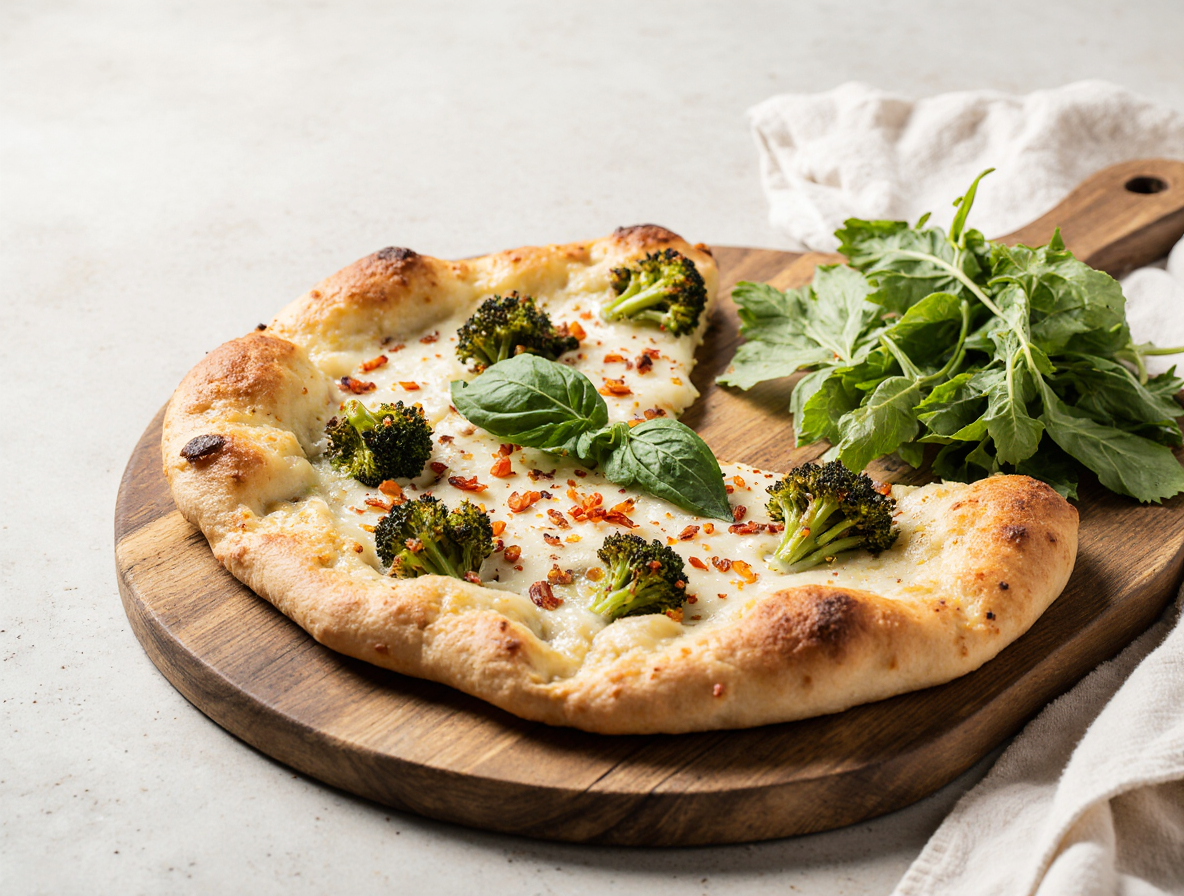How to Make the Perfect White Broccoli Pizza: A Foolproof Guide for Beginners
Looking for a delicious white broccoli pizza that’s ready in just 30 minutes? You’re in the right place!
This flavorful twist on traditional pizza doesn’t use tomato sauce. Instead, cheese is layered directly onto the crust before adding toppings. Every slice offers an irresistible combination of textures and flavors – crunchy broccoli and creamy ricotta cheese, enhanced with red pepper flakes, garlic, and fresh lemon zest on a perfectly crispy crust. Furthermore, if the idea of broccoli on pizza sounds unusual, just think of it as enjoying roasted broccoli dipped in a lovely cheese sauce.
What makes this white pizza with broccoli recipe particularly beginner-friendly is its versatility. You can use store-bought pizza crust to significantly reduce preparation time, or even prepare components in advance for quick assembly on busy weeknights. Additionally, the combination of steamed broccoli tossed in olive oil and red pepper flakes creates a delightful contrast against the creamy ricotta and mozzarella.
In this guide, we’ll walk you through everything you need to know about creating the perfect white broccoli pizza from scratch. Whether you’re new to homemade pizza or simply looking to expand your repertoire, our foolproof method will help you create a restaurant-quality dish right in your own kitchen.
What Makes White Broccoli Pizza Unique
What Makes White Broccoli Pizza Unique
No red sauce: what ‘white pizza’ really means
The defining characteristic of white broccoli pizza is right in the name – it’s “white” because it contains no tomato sauce. While traditional pizzas feature a red tomato base, white pizza (sometimes called “pizza bianca”) skips this ingredient entirely.
White pizzas typically feature a blend of white cheeses like ricotta, mozzarella, and parmesan as their foundation. The base often consists of olive oil infused with garlic, creating a flavorful foundation without the acidity of tomatoes. Some variations might include creamy alternatives like alfredo sauce, ranch, or even crème fraîche.
Interestingly, regional differences exist – American white pizzas frequently use a richer alfredo sauce with parmesan, garlic, and milk, while Italian versions tend toward a lighter approach with herbs, mozzarella, and olive oils.
Why broccoli is a great topping
Broccoli stands out as an excellent pizza topping for both flavor and nutritional benefits. This versatile vegetable is packed with vitamins C, A, and K, along with folate and dietary fiber.
On white pizza specifically, broccoli provides a welcome textural contrast – its slight crispness balances the creamy richness of the multiple cheeses. However, for best results, the broccoli should be pre-cooked through steaming or roasting rather than used raw, which could be tough and difficult to chew.
How this recipe differs from traditional pizza
Beyond just omitting tomato sauce, white broccoli pizza differs from traditional pies in several key ways. First, it tends to be more veggie-forward than meat-focused. While pepperoni dominates traditional pizzas, white pizzas commonly feature vegetables like spinach, artichokes, or mushrooms alongside broccoli.
Moreover, white broccoli pizza often incorporates unique flavor enhancers that would clash with tomato sauce – elements like lemon zest that brightens the entire dish or red pepper flakes that provide a pleasant heat.
Perhaps most importantly, white pizza recipes are generally more open to experimentation than their traditional counterparts. The neutral base of olive oil and cheese creates a versatile canvas for creative flavor combinations that might otherwise compete with tomato sauce.
Essential Ingredients and Prep Tips
Essential Ingredients and Prep Tips
Choosing the right pizza dough
Creating the perfect white broccoli pizza begins with selecting an appropriate dough. Store-bought dough saves considerable time and is readily available at most grocery stores or local pizzerias. Alternatively, making your own allows complete control over texture and flavor. For homemade dough, you’ll typically need instant yeast, honey, olive oil, flour, and salt. Some recipes even add grated Parmesan directly to the dough for extra flavor. Regardless of which option you choose, properly preheating your oven (often to 500°F) with a pizza stone inside is crucial for achieving that desirable crispy crust.
How to prepare broccoli for pizza
When prepping broccoli for pizza, cut florets into small, bite-sized pieces approximately ½-inch in size. This ensures they’ll cook evenly during baking. Subsequently, toss the broccoli with olive oil, salt, pepper, and red pepper flakes to enhance flavor. Although raw broccoli technically works, pre-cooking yields better results. Options include steaming for 2-3 minutes until bright green and crisp-tender, sautéing in olive oil with garlic, or roasting for deeper flavor. Afterward, pat the broccoli dry to prevent a soggy pizza.
Ricotta, mozzarella, and other cheese options
The cheese combination makes white broccoli pizza especially distinctive. Consider these options:
- Ricotta: Creates a creamy base (often mixed with garlic and seasonings)
- Mozzarella: Provides the classic melty texture (use cold, full-fat for best results)
- Parmesan/Pecorino Romano: Adds savory depth
- Asiago, goat cheese, or feta: Introduces tanginess and complexity
Optional sauces: olive oil, garlic, or alfredo
Since traditional white pizza lacks tomato sauce, the base requires careful consideration. Olive oil infused with garlic serves as the simplest option. Alfredo sauce offers richness but should be applied sparingly due to its heaviness. Even ricotta can function as a sauce when spread thinly across the dough. Naturally, each option creates a different flavor profile, so choose based on your preference for light or indulgent results.
Using fresh vs. frozen broccoli
Fresh broccoli generally produces superior texture and flavor, especially for achieving crispiness. Frozen broccoli works acceptably if thawed, drained thoroughly, and patted dry to remove excess moisture. Despite frozen vegetables having slightly fewer nutrients due to blanching, this loss is minimal compared to fresh options. During baking, fresh broccoli tends to roast better, whereas frozen requires extra attention to prevent sogginess.
Step-by-Step: How to Make White Broccoli Pizza
Step-by-Step: How to Make White Broccoli Pizza
1. Preheat oven and prep pizza stone or pan
Initially, place your pizza stone on the bottom rack of the oven. Heat to 450-500°F (232-260°C). Once the oven reaches temperature, allow the stone to continue heating for an additional 15 minutes to ensure it’s thoroughly hot. This extra time creates the perfect foundation for a crispy crust.
2. Roll out dough and brush with olive oil
Stretch your room-temperature dough into a 12-inch round on a floured surface. Alternatively, press or roll it out on parchment paper. Using a fork, prick several holes in the dough—a technique called “docking”. Next, brush with 1-2 tablespoons of olive oil, leaving a ½-inch border around the edges.
3. Add cheese base and seasoned broccoli
First, spread ricotta cheese (mixed with garlic, salt and pepper) evenly across the dough. Sprinkle about two-thirds of your shredded mozzarella on top. Following this, arrange your pre-cooked broccoli florets across the surface. Finish with remaining mozzarella to help hold everything in place.
4. Bake until golden and bubbly
Transfer the pizza directly onto the preheated stone. Bake for approximately 15-20 minutes until the crust turns golden brown and the cheese melts completely. Halfway through, consider rotating the pizza for even cooking.
5. Add finishing touches like lemon zest or basil
Finally, once out of the oven, let the pizza rest for 1-2 minutes. Immediately after, sprinkle with fresh toppings like lemon zest, fresh basil leaves, or a light drizzle of olive oil. These final touches add brightness to complement the rich, creamy base.
Pro Tips, Variations, and Storage
Pro Tips, Variations, and Storage
How to get a crispy crust every time
Achieving that perfect crispy crust starts with a fully preheated oven. In fact, placing your pizza stone in the oven throughout the entire preheating process ensures superior results. To enhance crunchiness, consider dusting your baking sheet with cornmeal first. High-quality ingredients also make a noticeable difference in the final product.
Vegan and dairy-free alternatives
For dairy-free enthusiasts, several options exist beyond traditional cheese. Cashew ricotta provides a creamy texture similar to dairy versions. Alternately, vegan cream cheese mixed with vegetable broth creates a fantastic sauce base. Even coconut oil-based or cashew-based cheese alternatives work wonderfully.
Add-ons: pine nuts, onions, or mushrooms
Elevate your white broccoli pizza with thoughtful add-ons. Chopped almonds or pine nuts add delightful crunch. Meanwhile, sautéed mushrooms, red onion slices, or roasted bell peppers contribute depth. For heat lovers, a drizzle of chili crisp brightens the entire pizza.
How to store and reheat leftovers
Store leftover pizza in an airtight container for up to three days. When reheating, avoid microwaves as they make the crust soggy. Consequently, the best results come from reheating in an oven at 250°F for 5-10 minutes. As another option, air fryers work excellently at 360°F for just 3-4 minutes.
Conclusion
White broccoli pizza stands out as a delicious alternative to traditional tomato-based pizzas. The combination of creamy cheese and crunchy broccoli creates a harmonious blend of flavors and textures that will impress both beginners and experienced home cooks alike. After trying this recipe, you might find yourself making white pizzas more frequently than the traditional red sauce varieties!
Making the perfect white broccoli pizza doesn’t require professional culinary skills. Actually, anyone can achieve excellent results by following the simple steps outlined in this guide. The key lies in proper preparation – preheating your oven adequately, pre-cooking your broccoli, and selecting the right cheese combination.
Additionally, this recipe offers tremendous flexibility. You can customize it based on your preferences or what’s available in your pantry. Pine nuts, onions, or mushrooms work wonderfully as additional toppings, while dairy-free alternatives make this dish accessible to those with dietary restrictions.
Remember, the success of your white broccoli pizza depends largely on achieving that perfect crispy crust. Therefore, take time to properly preheat your oven and pizza stone. The contrast between the crunchy base and the creamy toppings makes every bite truly satisfying.
Above all, cooking should be enjoyable! This white broccoli pizza recipe gives you room to experiment with different flavor combinations while still providing enough structure for consistent results. The next time you’re craving something different yet comforting, give this white broccoli pizza a try – you won’t be disappointed!
FAQs
Q1. Is it necessary to cook broccoli before adding it to pizza? Yes, it’s recommended to pre-cook broccoli before adding it to pizza. Steaming, sautéing, or roasting the broccoli beforehand ensures a better texture and flavor. This also prevents the broccoli from being undercooked or too crunchy on the finished pizza.
Q2. What are the key ingredients in a white broccoli pizza? A typical white broccoli pizza includes a blend of cheeses (such as ricotta and mozzarella), steamed broccoli seasoned with olive oil and red pepper flakes, and often garlic. It’s usually finished with fresh lemon zest for added brightness. Unlike traditional pizzas, it doesn’t use tomato sauce.
Q3. How does a white pizza differ from a regular pizza? The main difference is that white pizza doesn’t use tomato sauce. Instead, it’s typically made with a base of olive oil and garlic, topped with various cheeses like mozzarella, ricotta, and Parmesan. This allows for different flavor combinations and highlights the taste of high-quality cheese.
Q4. What’s the best way to achieve a crispy crust for white broccoli pizza? To get a crispy crust, preheat your oven with a pizza stone inside to a high temperature (around 450-500°F). Brush the dough with olive oil before adding toppings, and consider dusting your baking sheet with cornmeal. Bake until the crust is golden brown and the cheese is bubbly.
Q5. Can I make a vegan version of white broccoli pizza? Yes, you can create a vegan white broccoli pizza using dairy-free alternatives. Options include cashew ricotta, vegan cream cheese mixed with vegetable broth, or coconut oil-based cheese alternatives. These can provide a creamy texture similar to traditional cheese while keeping the pizza plant-based.


